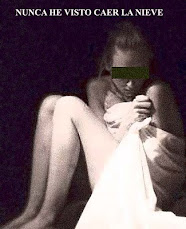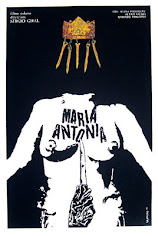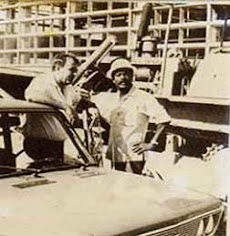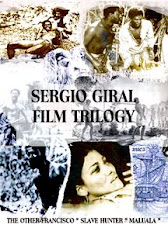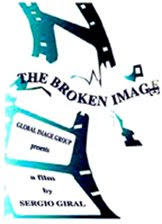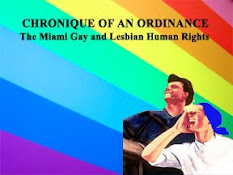giralmedia@yahoo.com
BIOGRAPHY
Sergio Giral is a renowned Black
Cuban-American film writer and director, born in Havana, Cuba from an American
mother and a Cuban father. He was raised in New York City, as an aspiring young
painter in the days of the Beatnick generation. In 1962 Oscar winner
cinematographer, Nestor Almendros, invited Giral to work together at the ICAIC
(The Cuban Film Institute). It was there, after a series of shorts and
documentaries, that Giral filmed his famous trilogy (The Other Francisco,
Rancheador, Maluala) about slavery on 19th. Century slavery Cuba and
the Caribbean. This trilogy won numerous awards and recognitions around the
world. In 1991, Giral returned to United State and since then he resides in
Miami.
FEATURE FILMS 2010 - 1975
DOS VECES ANA (Miami) 2010
MARIA ANTONIA (ICAIC- Cuba, 1990)
PLACIDO (ICAIC - Cuba, 1986)
GLASS ROOF (Techo de Vidrio) (ICAIC- Cuba, 1982) MALUALA (ICAIC- Cuba, 1980)
RANCHEADOR (ICAIC - Cuba, 1977)
THE OTHER FRANCISCO (ICAIC – Cuba, 1975)
SHORT FILMS 2016 – 1990
THE INVISIBLE COLOR
Miami 2016
AL BARBARO DEL RITMO: BENNY MORÉ, Miami 2004
CHRONICLE OF AN ORDINANCE (Miami 2000)
THE WAY OF THE ORISHAS, Miami 2000)
THE BROKEN IMAGE , Miami 1998)
DANCE AFRICA, Cultura del Lobo MDCC Miami 1995
CHICAGO BLUES, Miami 1991
LA JAULA
ICAIC 1963
LA MUERTE DE J.J.J. ICAIC 1964
CIMARRONA GONZALO ROIG
ANATOMIA DE UN ACCIDENTE
QUE BUENO CANTA USTED, BENNY MORE.
DOS VECS ANA 2008
THE PASSION ACCORDING TO ANTUNEZ 2007
THE SNOW 2000
RAFAELA’S SYNDROME 2000
NAKED BEACH 1999
GUNRUNNER 1994
SOLDIER BLACK 1994
MALUALA 1979
RANCHEADOR (SLAVE HUNTER)
1996
THE OTHER FRANCISCO 1974
THE OTHER FRANCISCO 1974
PROCLAIM CITY OF ATLANTA: SERGIO'S GIRAL DAY 4th. Atlanta Third World Film Festival. Atlanta, Ga. 1984.
INTERNATIONAL FILM FESTIVAL
AWARDS
FILM: MARIA ANTONIA 1994
OUR ESSENCES FILM FESTIVAL. New England. USA BEST FILM, BEST FEMALE ACTING.
1991
TRIESTE LATIN AMERICAN FILM FESTIVAL.
Italy; GRAND PRIZE.
1991 NEW YORK LATIN AMERICAN FILM FESTIVAL. BEST FEMALE ACTING
1990
GOYA (ACADEMY AWARDS) MADRID,
SPAIN. NOMINATION.
1989 HAVANA XI LATIN AMERICAN FILM FESTIVAL. MUSIC.
FILM: PLACIDO
1988
HARARE FILM FESTIVAL, Zimbabwe.
AWARD: SILVER CUP1987 SULMONA FILM FESTIVAL, Sulmona, ITALY. FIRST PRIZE
FILM: MALUALA
1980 HAVANA I LATIN AMERICAN FILM FESTIVAL. GREAT
PRIZE "CORAL"XXII INTERNATIONAL FILM FESTIVAL KARLOVY VARY. CIDALC PRIZE
FILM: RANCHEADOR
V
INTERNATIONAL PANAMA FILM FESTIVAL HUMAN RIGHTS AWARD III KINGSTON INTERNATIONAL FILM FESTIVAL. Jamaica. BEST FILM - BEST DIRECTOR.
FILM:
THE OTHER FRANCISCO
IX MOSCOW INTERNATIONAL FILM FESTIVAL FIPRESCI/ BEST ACTOR XVICARTAGENA FILM FESTIVAL.Cartagena, Colombia. PREMIO TEATRO
V RURAL FILMS FESTIVAL. SANTAREM, PORTUGAL. "CACHO DE ORO".
II KINGSTON INTERNATIONAL FILM FESTIVAL, Jamaica (1978)
AWARD: BEST FILM - BEST DIRECTOR.
SHORT
FILMS
CHRONICLE
OF AN ORDINANCE. BLACK INT. CINEMA (2003) BERLIN.
AWARD: BEST FILM/VIDEO DOCUMENTARY PRODUCTION DEATH OF J.J.J. LEIPZIG FILM FESTIVAL. GERMANY 1966. AWARD: UIE
POR ACCIDENTE. VII LABOR FILM FESTIVAL SOFIA, BULGARIA 1974
AWARD: BRONZE MEDAL
OFFICIAL SELECTIONS
CHICAGO LATIN FILM FESTIVAL 1996XV FESTIVAL DES 3 CONTINENTS, NANTE, FRANCE 1993.
MIAMI INT. FILM FESTIVAL, MIAMI – MARIA ANTONIA 1992
TELL-U-RIDE, COLORADO 1992 MARIA ANTONIA (STOCK IN CUSTOMS)
VIÑA DEL MAR FILM FESTIVAL, CHILE - MARIA ANTONIA 1991
GOYA 1991 (Nomination)
LONDON FILM FESTIVAL, UK – MARIA ANTONIA 1991
TORONTO FILM FESTIVAL- MARIA ANTONIA 1991
RIO INT. FILM FESTIVAL, BRAZIL – PLACIDO 1986
KARLO VIVARY FILM FESTIVAL – CZECHOSLOVAKIA - MALUALA 1980
GEORGE POMPIDU, Cuban film retrospective. Paris - 1980
BERLIN FILM FESTIVAL – RANCHEADOR 1978
MOST RECENT
PRESENTATIONS
UNIVERSITY OF NORTH CAROLINA at Charlotte, NC
“Dos Veces Ana
UWMILWAUKEE, Milwaukee, “Dos Veces Ana”
FESTIVAL DE CINÉMA DE DOUARNENEZ,
France, 2010
FIFET (Festival
international du film contre l'exclusion et pour la tolérance) Paris, France.
Dec 2008
JOURNÉE NATIONALE
POUR LA MÉMOIRE DE L’ESCLAVAGE Musée Dapper, Paris, France, 10 May
2008
CELEBRATION OF BLACK HISTORY MONTH 2008
The Tower Theater, MDCC. Miami.WALTER READ THEATER, Sergio Giral Film Retrospective
Lincoln Center, New York, N.Y. 1999
MEGACINE Mega TV 8/11/07 Miami
POLOS OPUESTOS Mega TV Miami 2007
FILMS OF SERGIO GIRAL; University Of San Diego, Calif. April 25, 2007
FILMS OF SERGIO GIRAL UCLA International Institute April 27, 2007
DOS CINEASTAS Y SUS VISIONES DESDE EL EXILIO 2006 MDCC Tower Theater, Miami..
CENTER FOR LATIN AMERICAN STUDIES University Of California, Berkley 2/11/2004
A DIRECTOR’S VIEW OF ADAPTATION 4th CRI Conference on Cuban and Cuban-American Studies March 6, 2002 FIU
EDUCATION
HUMANITIES UNIVERSITY OF HAVANA 1977-1972
PAINTING ART STUDENTS LEAGUE NEW YORK NY. 1960-1958SPANISH- ENGLISH
FILM EXCERPTS
“The Other Francisco
transcends the practice through theory creation of an aesthetic history lesson
and therein lies the startling innovation” Dennis West, The Other
Francisco, A reinterpretation of Slavery in the Americas
“By contrast, The
Other Francisco, is a brutal film , laying bare the suffering endure by slaves
in the Americas. Instead of Haley’s “fiction”, where, in order to smooth over
the rough edges of past, fiction adorn history,
Giral confronts popular myth with the objective conditions, the atrocities of
history”.. Mac Margolis, Film Review.
Bring the black Cuban experience onto the screen” Karen Juanita Carrillo, The Dean of Afro-Cuban films, bfm May/June 2006
“This films comprise a thorough reworking of the
Hollywood plantation myth”
Gary Dauphin, Rebel Revel The Village Voice
2/Feb/1999.
“Sergio Giral’s films have always dealt with the
African roots of Cuba and how they have affected Cuban society” Helga
Stepheson.
“Breaking of the rules: Maria Antonia” Honolulu
Weekly June/8/1994
“La Imagen Rota es un documento necesario
porque de lo contrario se hubiera perdido un grupo de testimonios dispersos en
la diáspora” Alejandro Ríos,
La Imagen Rota del Cine Cubano, Armando Correa El Nuevo Herald, marzo 31, 1995.
“Dos veces Ana es
por todo eso una película noble, magnífica, con un guión muy pensado y mejor
estructurado y una extraordinaria dirección de actores. Es una gran película,
hecha en los bajos fondos del capitalismo, que encajaría en el llamado Cine
Pobre o del Dogma, sin quererlo, y lo mejor, sin ser pobre y sin ser dogmática,
en todo el sentido de la palabra, sobre todo en el fílmico”. Dos Veces Ana o el renacimiento de un cine de claves
históricas e irónicas. Zoe
Valdés blog December 29, 2011
DOS VECES ANA, DE SERGIO GIRAL, O EL RENACIMIENTO
DE UN CINE DE CLAVES HISTÓRICAS E IRÓNICAS. Zoe
Valdés blog December 29, 2011
FORGET IT, JAKE. IT'S CHINATOWN." INTERVIEW TO
SERGIO GIRAL (Spanish). Magdiel Aspillaga. Feb 7
2010CONTACTO MAGAZINE Dos Veces ana, una película de tema racial , Jesús Hernándes Cuellar. 1/15/2010
SERGIO GIRAL Vuelve a la pantalla grande con DOS VECES ANA
Arturo Arias Polo , El Nuevo Herald, 12/06/08
THE
DEAN OF AFRO-CUBAN FILMS Karen Juanita Carrillo, bfm May/June 2006
UNA TARDE CON DOS VECES ANA: Olga Connor, El
Nuevo Herald, 2/9/2008
CUBAN CULTURE MOVIES
ON TV. Enrique Fernandez. The
New Herald, 8/6/2007
BENNY MORE EN LAS
PANTALLAS DEL FESTIVAL. Evelio Taillacq. El Nuevo Herald. 4/23/2004
GUIA CRITICA DEL
CINE CUBANO DE FICCION: Juan A García
Borrero. Arte y Literatura. Cuba
2001 HISTORIA DEL CINE CUBANO: Eduardo G. Noguer. Ediciones Universal, Miami 2002
SERGIO GIRAL, SU PRIMER FILM EXILIADO. Marcia Facundo. El Nuevo Herald. El Nuevo Herald, 15 de junio del 2001
THE STRAIGHT STORY OF SAVE DADE. Celeste Fraser Delgado, Miami New Times 4/13/2000.
REBEL REVEL. REVOLUTION AND BEYOND Gary Dauphin. Village Voice (2/ 2/99).
HISTORIA DEL CINE CUBANO: Eduardo G. Noguer. Ediciones Universal. Miami USA 1999
"AFROCUBA: AN ANTHOLOGY OF CUBAN WRITING ON RACE, POLITICS AND CULTURE," in Forster, Imogen, Race and Class , vol. 36, no. 3, January-March 1995.
AFROCUBA (IMAGES AND ICONS). Pedro Perez Sarduy & Jean Stubbs. Ocean Press 1993
SMUGGLED (A DIRECTOR NOT STRAIGHT OUT OF CUBA) Nat Chediak, Interview (2./93)
MARIA ANTONIA:'SE LAS TRAE' Rene Jordan, El Nuevo Herald (2/ 5/ 1993)
FIRST CUBAN FILM FOCUS ON EVERYDAY PEOPLE. Rene Rodriguez, The Miami Herald (2/93)
EL CINE DE SERGIO GIRAL LLEGA A MIAMI Mireya Novo, EXITO 10/92
CINCO FILMES DE SERGIO GIRAL EN EL EXILIO. Norma Niurka, El Nuevo Herlad (10/92)
BEATNIK, DIRECTOR, DEFECTOR. Elinor Burkett, The Miami Herald 4/25/92
LE CINEMA CUBAIN. Antonio Paranagua, CENTRE GEORGE POMPIDOU, Paris (1990)
THE AFRO CUBAN HERITAGE , Conversations with Filmmakers 0000 The Black Scholar (summer 1 Burton, Julianne, editor, Cinema and Social Change in Latin America:, Austin, Texas, 1986.
THE OTHER FRANCISCO: CREATING HISTORY. Julia Lesage, JUMPCUT NO.30 (3/ 85)
THE CUBAN IMAGE. Michael Chanan, BRITISH FILM INSTITUTE, London. (1985)
THE OTHER FRANCISCO: FILM LESSONS ON NOVEL READING," Masiello, Francine, " Ideologies and Literature , January-February 1978
IMAGES AND SON, Grelier, R., in Image et Son (Paris), March 1977.
"CUBAN CINEMA AND THE AFRO-CUBAN HERITAGE: AN INTERVIEW WITH SERGIO GIRAL," in Black Scholar , Summer Crowdus, Gary, and Julianne Burton, 1977.
HOLLYWOOD REPORTER , 7 July 1977.
THE OTHER FRANCISCO. Dennis West, CINEASTE 8, 2 (1977): 47
VARIETY, H., in Variety (New York), 6 August 1975
THE OTHER FRANCISCO: A REINTERPRETATION OF SLAVERY IN THE AMERICAS. Marc Margolis, 1975) FILM REVIEW
MIAMI 2016







.jpg)


















